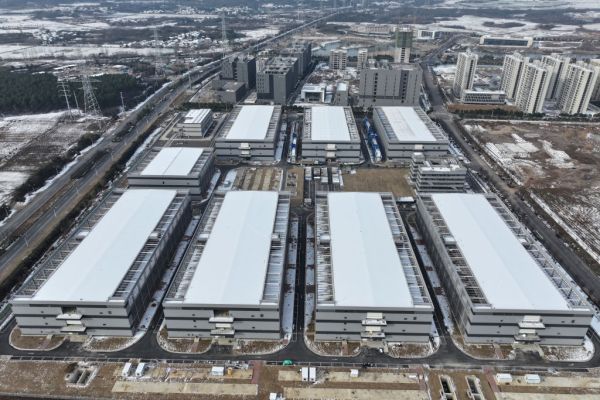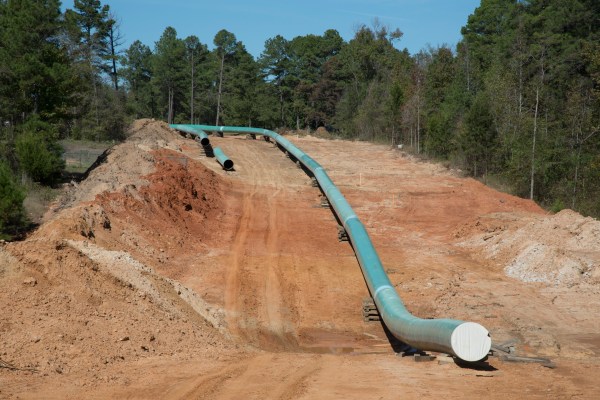Turn any article into a podcast. Upgrade now to start listening.
Premium Members can share articles with friends & family to bypass the paywall.

Editor’s Note: Energy policy is at the center of some of the most important topics we cover here at The Dispatch, from national security and geopolitics to economic growth and technological innovation. We’re proud of the work we’ve done on the subject thus far, but we’ve never had a product dedicated to exploring the debates that are going to shape our energy future—until today.
Welcome to Dispatch Energy.
Featuring a rotating roster of contributors who are experts in their respective fields, this new newsletter is included with your membership at no additional cost, thanks to support from Pacific Legal Foundation. Published every Thursday, Dispatch Energy will cover topics ranging from oil and gas and permitting regulations to renewables, nuclear, the grid, and climate considerations.
Whether you’re an industry expert or someone who simply wants to better understand the forces shaping energy policy, Dispatch Energy is for you. Our goal is not to dumb issues down or shy away from complexity, but cover these topics in an intellectually honest and accessible manner, presenting alternative perspectives and acknowledging the tradeoffs inherent in any policy decision.
Click here to make sure you receive Dispatch Energy in your inbox every week. And if it’s not for you, you can adjust your preferences on our newsletters page.
Without further ado, here is Philip Rossetti of the R Street Institute with the inaugural edition …
Editor’s Note: Energy policy is at the center of some of the most important topics we cover here at The Dispatch, from national security and geopolitics to economic growth and technological innovation. We’re proud of the work we’ve done on the subject thus far, but we’ve never had a product dedicated to exploring the debates that are going to shape our energy future—until today.
Welcome to Dispatch Energy.
Featuring a rotating roster of contributors who are experts in their respective fields, this new newsletter will be unlocked courtesy of the Pacific Legal Foundation. Published every Thursday, Dispatch Energy will cover topics ranging from oil and gas and permitting regulations to renewables, nuclear, the grid, and climate considerations.
Whether you’re an industry expert or someone who simply wants to better understand the forces shaping energy policy, Dispatch Energy is for you. Our goal is not to dumb issues down or shy away from complexity, but cover these topics in an intellectually honest and accessible manner, presenting alternative perspectives and acknowledging the tradeoffs inherent in any policy decision.
Click here to make sure you receive Dispatch Energy in your inbox every week. And if it’s not for you, you can adjust your preferences on our newsletters page.
Without further ado, here is Philip Rossetti of the R Street Institute with the inaugural edition …
Editor’s Note: Energy policy is at the center of some of the most important topics we cover here at The Dispatch, from national security and geopolitics to economic growth and technological innovation. We’re proud of the work we’ve done on the subject thus far, but we’ve never had a product dedicated to exploring the debates that are going to shape our energy future—until today.
Welcome to Dispatch Energy.
Featuring a rotating roster of contributors who are experts in their respective fields and published every Thursday, Dispatch Energy will cover topics ranging from oil and gas and permitting regulations to renewables, nuclear, the grid, and climate considerations.
Whether you’re an industry expert or someone who simply wants to better understand the forces shaping energy policy, Dispatch Energy is for you. Our goal is not to dumb issues down or shy away from complexity, but cover these topics in an intellectually honest and accessible manner, presenting alternative perspectives and acknowledging the tradeoffs inherent in any policy decision.
Click here to make sure you receive Dispatch Energy in your inbox every week. And if it’s not for you, you can adjust your preferences on our newsletters page.
Without further ado, here is Philip Rossetti of the R Street Institute with the inaugural edition …
A New Energy Policy Buzzword

For the inaugural edition of Dispatch Energy, what better topic than the Abundance movement and its influence on the nation’s permitting reform debate? Although “Abundance movement” sounds like something a focus group might name a minivan, it actually reflects a rare moment of comity and bipartisanship. Rising energy prices and housing costs have forced some historically pro-regulation Democrats to rethink their positions and join free marketeers in the quest to make America more affordable.
Permitting barriers are real.
The movement refers to the bipartisan recognition that many of today’s rising costs (housing, electricity, food, etc.) are at least partially attributable to artificial constraints imposed by government policy—something we in the biz call “government failure.” This is basic economics: As the government implements new regulations, it creates barriers to market entry. The result is reduced production, which leads to a lower supply, resulting in higher costs.
These concerns have moved beyond theory. The ever-amorphous bogeyman of “red tape” is a demonstrable problem today and not so easily dismissed. As my own research at the R Street Institute has shown, the time it takes to obtain the highest-level permits from the federal government increased from a median of around two years in 2010 to nearly five by 2016. Perhaps ironically for environmentally minded Democrats, it’s clean energy projects that are the most likely to face high-level environmental reviews. About 12 percent of renewable projects permitted by the Bureau of Land Management required an environmental impact statement, compared to just 0.3 percent of oil and gas projects.
Similarly, permitting is disproportionately a clean-energy issue. According to the federal permitting dashboard, which tracks major infrastructure permits, 90 percent of energy-related projects in 2023 were for clean energy while only 3 percent were for fossil fuels (a disparity due to both shifts by investors toward clean energy and the typically large footprint of new clean energy projects). Additionally, grid interconnection for new electricity generation once took less than two years, but now takes an average of five. On the higher end of permitting difficulty, it takes an average of 29 years for a new mine to go from discovery to operation. And remember the California High-Speed Rail project? It was supposed to start initial operations around 2020, but is now projected to begin operating in 2032—24 years after approval.
The overwhelming recognition across industries is that it is too difficult to build anything in the United States, and this sentiment has finally reached policymakers. But just because politicians agree a problem exists doesn’t mean they agree on the solution, and it’s the latter part of the equation that has made the Abundance movement so topical.
Abundance—not just for free marketeers anymore.
The idea of “abundance” is the traditional purview of the right-leaning libertarian camp in politics. It is the classical capitalism vs. communism debate that colored the Cold War, with the age-old question of whether free markets or government is better at increasing production. But what is most surprising about the Abundance movement is that it seems to be resonating more with today’s left than the right.
House Democrats formed the bipartisan Build America Caucus in May with the goal of removing permitting barriers. “One of the cruelest ironies in America is that we have more laws restricting the supply of affordable housing than expanding it,” Democratic Rep. Ritchie Torres said. “That’s neither progressive nor pro-working class. It’s time for every elected official to embrace an agenda of abundance—an abundance of opportunity for all Americans.” Democrats and Republicans are finally coming together on permitting reform, with at least three significant bipartisan permitting bills currently under consideration.
But who is embracing the abundance concept is perhaps more interesting than congressional efforts. Earlier this year, New York Times columnist and liberal commentator Ezra Klein and The Atlantic’s Derek Thompson released their book Abundance. The book highlights why it is important to build things, and critiques progressives’ inability to address the supply side of the economic equation (something Klein confronted in a 2021 column for the Times).
Since then, that book has featured on former President Barack Obama’s summer reading list, and California Gov. Gavin Newsom invited Klein onto his podcast to discuss it. Yes, the same Barack Obama who supercharged the regulatory state with his “pen and phone” approach to governance, and the Gavin Newsom who has shuttered oil refineries in his home state, are now highlighting how too much regulation impedes abundance.
As a free marketeer, I must confess that I’ve rolled my eyes watching the left flock to this “new” idea that perhaps regulations can be poorly crafted and need to be rethought, but I applaud the growth of the Abundance movement. Messengers matter in politics, and it’s especially true for this topic, where an emerging question is whether some environmental regulations are doing more harm than good.
Well-intentioned policy can still be a problem.
In seeking to identify barriers to new construction, many people have pointed to “NIMBYism” (not in my backyard!), where local opposition is the key impediment. Much of this is intuitive: homeowners who know their property value will fall if the housing supply increases, or wealthy residents of McLean, Virginia, who don’t want one of the nation’s busiest highways to further encroach on their neighborhoods. But from a policy perspective, there are specific mechanisms by which people can create a “vetocracy,” and it’s not just local opposition. Public interest groups routinely weaponize environmental laws during the permitting process to delay projects they oppose.
The long-held maxim of environmental policy and permitting was that new development is environmentally destructive, while regulation preserves environmental quality. From a classic economics perspective, this is reasonable: If an industry does not bear the costs incurred as a result of its pollution (called an externality), then a government regulation can yield a public health benefit that outweighs the burden of the regulation (for example, the Acid Rain Program). But what has come into clearer focus recently is that environmental laws have become barriers to projects that would improve the environment.
A major mine in Nevada that would provide lithium for electric vehicles was held up due to the presence of a rare species of buckwheat on the same land. A Maryland light rail project was halted because an environmental advocacy group argued that permitting agencies should consider endangered species that might live in the construction zone (spoiler alert: no endangered species were in the construction zone). And among the most common opponents of renewable energy projects are (checks notes) environmental justice advocates. In recent years, there has been a growing consensus that environmental laws can be abused.
Much of the current focus at the federal level is on the National Environmental Policy Act (NEPA). The law lays out the process by which the government ensures that permits it issues comply with relevant environmental laws, including the Endangered Species Act and Clean Water Act. Not everything the federal government permits moves through NEPA, but any project big enough to have a “significant environmental impact” (i.e., any major infrastructure project) does. It is also the mechanism by which permits are frequently litigated, allowing concerned groups to assert that the federal government erred in issuing a permit.
But NEPA is, at least recently, less about environmental protection and more about preventing new construction. A report by the Breakthrough Institute found that 1) permits under NEPA are litigated more today than in the past, with a 56 percent increase in appeals from 2013 to 2022 compared to prior years; 2) 72 percent of all challenges to NEPA decisions come from nongovernmental organizations, with just 10 groups accounting for 35 percent of all cases; 3) the government wins about 80 percent of these cases (so the litigation is only causing delays in the large majority of cases, not changing project proposals); and 4) despite these lawsuits mostly originating from environmental justice advocates, only 2.8 percent of litigations pertained to those issues.
In short, a handful of litigious organizations are ensuring that as many projects as possible get snarled in courts, even if they aren’t arguing the project is bad for the environment. The Supreme Court reached this conclusion earlier this year when a rail line was challenged for failing to consider how oil transported by rail could worsen climate change. The justices unanimously agreed that this overly broad interpretation of what the government should consider in its permits was improper, and the majority opinion contained a blistering rebuke of lower courts for needlessly delaying projects.
The result is that even though NEPA reform has long been regarded as a Rubicon that environmentalists should never cross, policymakers are recognizing that even modest changes to the law to avoid a litigation doom loop would be good for the economy and environment. This includes things like requiring litigants to let agencies know where their environmental reviews are falling short before bringing a lawsuit, or allowing agencies to use existing environmental analysis where applicable. In short, permitting reform.
Bipartisanship is good for making policy durable.
While Republicans have focused on permitting reform for a long time, it was viewed by liberals as the agenda of monocle-wearing oil executives seeking personal wealth at the expense of the environment. When prominent voices like Newsom and Obama now argue that government shouldn’t impede production, it reaches new audiences. This ensures that resultant compromises are long-lasting and can signal to industry that it is safe to build.
This is ultimately why I’m optimistic about Abundance and permitting reform. While Washington rarely functions well, if there is enough constituent demand for change, it will typically happen. If both sides agree that “red tape” is indeed a problem, maybe we will finally see permitting reform progress.
A message from Pacific Legal Foundation
Defending freedom and human flourishing since 1973
Pacific Legal Foundation has been suing the government for over 50 years. We’ve brought 20 cases before the Supreme Court and earned 18 victories defending Americans’ constitutional rights.
Now, in the wake of our landmark victory in Sackett v. EPA, we’re doubling down with the launch of our Environment and Natural Resources practice—working to transform environmental law into a platform for prosperity, rather than fear.
Policy Watch
- Last week, Republican Rep. Andy Barr of Kentucky and Democratic Rep. Scott Peters of California reintroduced the Streamlining Powerlines Essential to Electric Demand and Reliability Act, legislation aimed at making it easier to construct large electric power transmission lines. Improved transmission line access has been a major priority of renewable energy, which often requires new transmission to connect customers to locations that are optimal for wind or solar generation.
- Ukraine has a new strategy in its war against Russia: the use of long-range drones to target its adversary’s petroleum resources and infrastructure. Over the weekend, Kyiv used the weapons in successful strikes against an oil pumping station in Russia’s Chuvashia region, roughly 600 miles from the Ukrainian border. While Russian officials deny that these attacks have affected their energy supplies, Moscow recently extended a ban on fuel exports to alleviate their domestic supply shortages.
- On Monday, the Trump administration announced a plan to invest $625 million in the coal industry through the Department of Energy. The administration argues that the move will reduce electricity costs and improve reliability by increasing the availability of coal power, but critics argue the initiative will increase pollution and raise costs by incentivizing the retention of older and less efficient power plants.
Innovation Spotlight
- Nuclear waste disposal company Deep Isolation has partnered with Navarro, a firm that contracts with the government on waste management and cleanup. The primary form of nuclear waste is spent nuclear fuel (SNF), which are physical rods that hold uranium fuel pellets for insertion into a reactor. After being used as fuel, the rods become highly radioactive and are typically stored in pools at the power plant because water is extremely effective at shielding radiation. However, this is only a temporary solution and there is no permanent repository for the approximately 95,000 metric tons of SNF in the United States. Deep Isolation, which first demonstrated its technology in 2019, is hoping to solve this problem by using the same directional drilling technology used for oil to store SNF deep underground where it poses no risk.
Further Reading
- With the Inflation Reduction Act’s energy subsidies dismantled, will climate hawks return to the strategy of pressing for a major climate law? Probably not, Ted Nordhaus and Alex Trembath of the Breakthrough Institute explain in the Ecomodernist. They argue that during the Biden years, the incremental “quiet” climate policy gave way to the bombastic “green vortex” strategy, which entailed spending as much money as possible with a particular focus on Republican districts in the hopes that this would build constituencies that would defend green subsidies. Nordhaus and Trembath argue that this approach failed to appreciate the fiscal limitations of the high-cost strategy, especially when compared to higher priority spending items for Republicans (like tax cut extensions). Nordhaus and Trembath argue that the path forward for climate policy will be one that is focused on costs and tradeoffs rather than big, politically vulnerable climate bills.







Please note that we at The Dispatch hold ourselves, our work, and our commenters to a higher standard than other places on the internet. We welcome comments that foster genuine debate or discussion—including comments critical of us or our work—but responses that include ad hominem attacks on fellow Dispatch members or are intended to stoke fear and anger may be moderated.
With your membership, you only have the ability to comment on The Morning Dispatch articles. Consider upgrading to join the conversation everywhere.